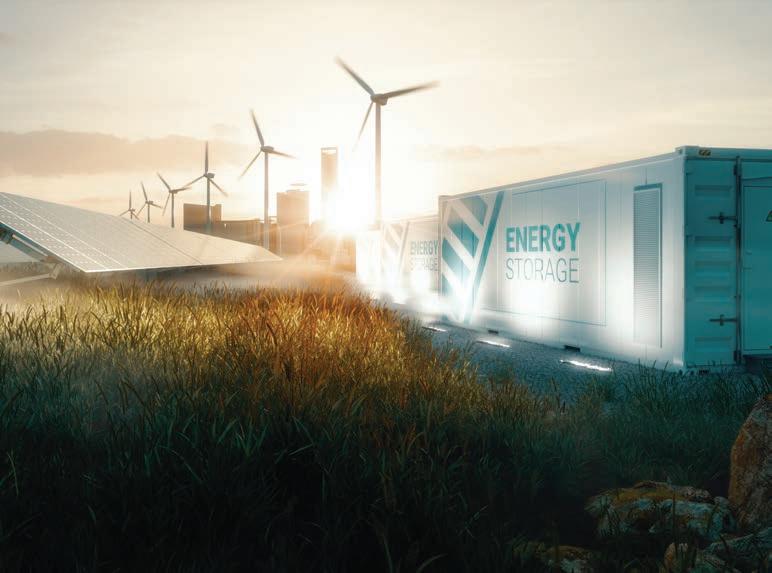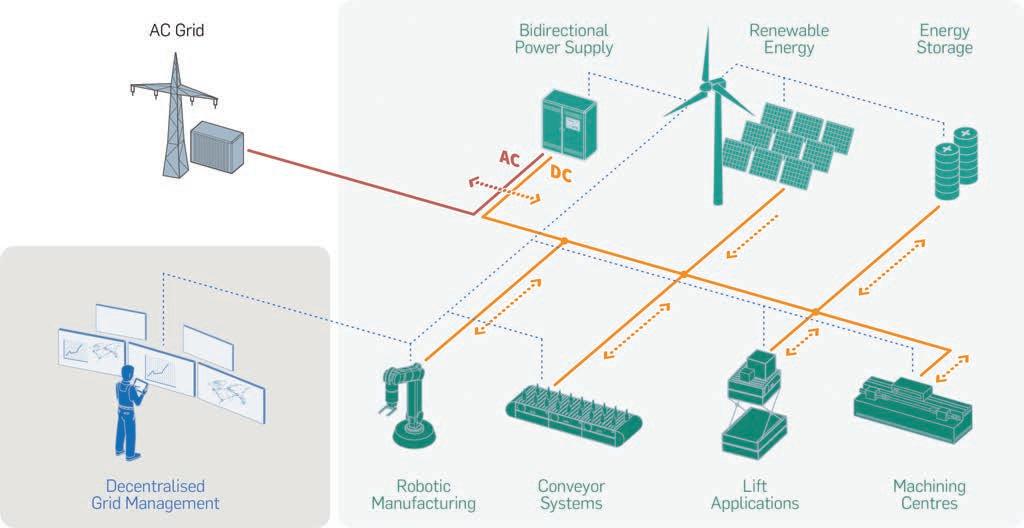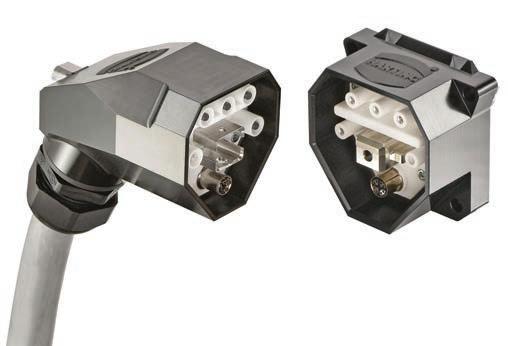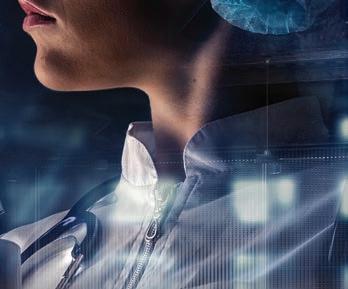
7 minute read
Power Up
Photo credit: © Petmal / iStock / Getty Images Plus
DC for Industry promises to super-charge the benefits of green power.
BY DAVID GERSOVITZ
For anyone passing the Whirlpool manufacturing complex in central Ohio or the Honda Transmission plant downstate, the wind turbines dominating those properties make a powerful statement about industry generating green power for its operations.
Many more plants are generating solar power onsite. Globally, installation of photovoltaic (PV) panels by industry is outpacing solar uptake in the residential and commercial sectors. While some of that industrial solar output is sent to utilities to offset conventional power use, many other companies are using it inside the plant. That’s the case in manufacturing and processing, at breweries and candy factories, automakers, textile mills, distribution centres, and even cannabis grow-ops. Wind turbines and PV panels generate direct current (DC). Companies integrating their own DC power into operations are functioning semi-autonomously or even fully independent from their local utility’s alternating current (AC) supply, cutting the cord or, at most, keeping the latter as backup.
Soon, it will be possible to further autonomize by replacing a facility’s internal electricity infrastructure with a DC smart grid to power most production systems. The technology, often called DC for Industry, is being developed globally.
The headline benefit of DC for Industry is significant in-house energy savings, ranging up to 15% or more. There will be potential integration with high level plant control systems and, of course, carbon footprint reduction. There will also be opportunities for lower materials and maintenance costs, even improvements in machine and process design.
DC R&D
DC smart grid research projects are identifying and testing DC topologies and infrastructure in real world conditions. The development of global standards has begun. For some companies, implementation will upend a century-old relationship with the utility power grid.
Early 20th century utilities established dominance by leveraging AC’s comparable advantage. Unlike DC at the time, AC could be stepped up to very high voltages, transmitted over long distances from huge generating complexes with little energy loss. It’s then stepped down to voltages suitable for running machinery or household appliances.
Though banished from the utility network, direct current never disappeared. It powers smart phones, flat-screen TVs, LED light strips and most anything battery-powered. In industry, DC-powered servo, stepper and other brushless motors are relied on for many functions. However, wherever AC is converted to DC on a per-device basis, there is an energy loss, usually 5-20 percent, that adds up throughout a factory.
When a plant’s AC power supply is centrally converted to DC just once, however,

The microgrid concept with decentralized management of a bidirectional, internal DC smart grid gives industry more control over energy supply and new opportunities to increase energy efficiency.
those losses are reduced. In data centres, estimates of the aggregate AC to DC conversion loss range from 15-30%. Japanese telecom NTT, for example, claimed a 15% saving at one centre by replacing AC to DC converters at each server with more efficient centralized inverters.
MICROGRIDS
With greater ambition, much more will be gained. For those switching to a DC smart grid, a logical follow-on will be reconfiguring a plant or warehouse as a microgrid and taking complete control of its energy supply.
Electric utilities generally operate with a built-in inefficiency, in that they often generate or contract for more power than they require. By contrast, a factory microgrid would promote maximum efficiency. Whatever it generates, stores or purchases (both when, how much and from whom) would be for the facility’s sole benefit.
A locally-managed microgrid that integrates DC or hybrid in-feeds (for example, grid AC converted to DC and combined with DC generated on site or nearby) with high-capacity battery storage and an internal DC smart grid would offer improved power supply stability and security. It would de-peak operations and provide a steady, well-buffered current. Its relative autonomy would reduce or eliminate utility-caused fluctuations, blackouts, brownouts or rationing calls.
Potentially, DC feeds can be precisely matched to specific applications. DC-Industrie, a German multi-stakeholder research project, was able to reduce the feed-in power to an automotive robotic welding cell from 450kw to 50kw by the seamless integration of high-speed storage.
Harting’s proposal for an industrial DC connector that transmits AC/DC power, signals, Ethernet/data and autonomous interlock BRAKING ENERGY REVENUE

A DC smart grid can be bidirectional, recovering and re-using braking energy from production equipment like variable-speed drives or cranes. Waste energy recovery operates on essentially the same principle as regenerative braking on a car: Excess kinetic energy is captured when decelerating and stored for use when accelerating.
Recovered power can be stored for backup or peaking purposes or turned into a revenue stream. Germany’s DC-Industrie researchers estimate a reduction in AC to DC/DC to AC converters with recovery of braking energy can yield plant-wide savings of 6-10% in manufacturing.
The materials required for a DC smart grid are potentially less expensive since DC cabling has less copper and insulation. In addition, a DC smart grid doesn’t require as many converters and other electronic devices connected to the plant’s DC mains. Having fewer on-board components–like rectifiers, converters, line reactors, filters or brake resistors–will enable designers
to shrink some production equipment. High power electronics could be mounted closer to a motor, or even integrated into it, shortening or dispensing with expensive shielded motor cables.
Many existing components in plant electricity distribution are DC-ready or readily adaptable. Where new technology is required, development is under way at companies like Harting, which has focused on heavy duty connectors over its 76-year history.
With DC mains, the voltage can be slightly higher – in a range of 650-800V – than the typical 400-600VAC network. Sparking and arcing can occur if any industrial connector is disconnected under load, regardless of current type.
With AC connectors, passive deterrents such as blocking plates or padlocks are usually sufficient to prevent disconnecting under load. The risk is greater with direct current, so DC connectors will require an embedded actuator to perform active locking, says Norbert Gemmeke, Managing Director of Harting Electric GmbH.
“This can be by an autonomous interlock in the connector,” he says, “or by the connector’s integration into the control system of the plant or system technology.”
A CATALYST FOR CHANGE

Since the invention of the water wheel, each energy revolution has produced profound changes in manufacturing. Steam age factories rose vertically, to locate machinery close to the central boiler. Energy was distributed via metal shafts and wide leather belts.
With mass electrification in the 1920s, those shafts and belts gave way almost overnight to electric cables and motors. Production spread out linearly. New plants adopted more space-efficient, single-story layouts. Conveyor belts, pioneered for mining, moved indoors.
In a similar fashion, DC for Industry in conjunction with megatrends like digitalization (IIoT/Industry 4.0), artificial intelligence, 3D printing and field-to-cloud deterministic Ethernet will alter how things are made and processes controlled.
In the larger societal context, DC for Industry can help North American plants face energy uncertainty. Questions abound, such as, where will the additional electricity for a net zero carbon economy come from? Can the continental grid system adapt to a post-carbon future?
Right now, the economics are bending towards renewables and locating them close to where the power is needed. Solar PV costs have plunged while panel efficiency keeps improving. The same is happening to large-scale battery storage. DC for Industry, as a standalone solution for improving internal energy efficiency or as part a microgrid, will provide adopters with a tool to reduce or even eliminate supply concerns while improving their competitive position. |DE
www.harting.com
This article was submitted by Harting.
Automation Moving at the Speed of Life!




The Life Science industry draws on a wide range of technologies, services and products. While the objectives within each sector may differ, the need for innovation and rapid development is critical for companies industry-wide. Festo delivers on both fronts. With our team of highly specialized engineers and a vast array of customer resources, we produce tested and proven product solutions that help you meet your performance objectives while optimizing time-to-market.
For more information:
www.festo.com/biotech
life.sciences.nam@festo.com







